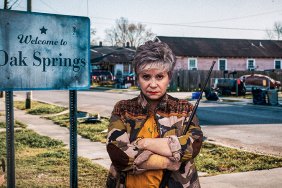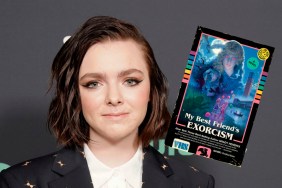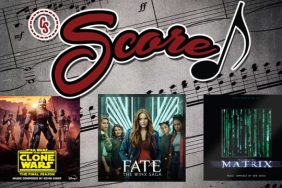
Grady Hendrix Talks Paperbacks from Hell
During the Fantasia Film Festival this past summer, we had the opportunity to sit down and talk to author and screenwriter Grady Hendrix about his new book Paperbacks from Hell: The Twisted History of ’70s and ’80s Horror Fiction. To write this book, Hendrix read over 300 lurid paperbacks from the golden era when animal attacks, creepy kids and haunted houses were king. We also got to see his brilliant live one-man show about Paperbacks from Hell, which will be happening at Brooklyn New York’s Film Noir Cinema (via the Miskatonic Institute of Horror Studies) this coming Tuesday, September 19 at 7 p.m. to celebrate the release of this fantastic book. Get your tickets here!
Click here to order your copy of Paperbacks from Hell!
“There wasn’t much horror fiction that was marketed as horror fiction,” Hendrix explains, “but then ‘Rosemary’s Baby’ came along and then ‘The Exorcist’ and ‘The Other’ back to back. It sort-of created the genre. Horror was hitting the bestseller list for the first time since the ’40s. It was for adults, it wasn’t kids stuff. It wasn’t ‘The Munsters’ or ‘Dark Shadows.’ It sparked this huge boom and a lot of it became paperback originals. Through the’70s and ’80s you have this huge wave of paperback horror with lurid covers on drugstore racks. There’s a lot of great books in there, there’s a lot of terrible books, but by ’93 the wave started to die out with the serial killer boom as ‘Silence of the Lambs’ won all those Oscars in ’91. By ’96 the last horror line was gone. So from ’71 to ’93 is filled with these horror books, and the authors were forgotten or had moved on to romances. It went away.”
The Paperbacks from Hell book spans this entire era from the initial public fascination with Satan and possession through the ’90s splatterpunk books of Clive Barker, Poppy Z. Brite and others. It also contains hundreds of glorious full-color pictures of the brilliant paperback book covers, occasionally telling the stories of the artists behind them. It was one such cover that drew Hendrix into this world in the first place.

“I discovered this book called ‘The Little People’ with these Nazi leprechauns on the cover and I wound up reading it and was like, ‘You know, there’s 100 pages in the middle of this that is CRAZY good!'” said Hendrix. “If Charles Band had less taste it would be like a Charles Band movie. There’s this woman who inherits this castle in Ireland and turns it into a B&B, and an old couple is there for opening weekend and it turns out he was a Nazi concentration camp guard and she was a Jewish concentration camp prisoner. They meet cute in concentration camp, fall in love and get married, and I’m like, ‘Did no one say this is beyond bad taste?’ It’s bonkers.”
Hendrix also goes to bat for forgotten authors like Mendal W. Johnson (Let’s Go Play at the Adams’), Charles L. Grant (Shadows) and southern gothic master Michael McDowell (the Blackwater series).
“Twenty-five percent of these books are amazingly over-the-top, weird and bad,” Hendrix says. “Then there’s a further twenty-five percent that are legit great books where it pisses me off that we’ve forgotten these authors.”
He covers many crazes that swept through the publishing world, from real-estate nightmares to cults to evil dolls, with animal attacks being a particularly fun subject.
“England is menaced by so many animal attacks because James Herbert’s ‘The Rats’ was such a success,” Hendrix adds. “After awhile people forget the initial inspiration, so eventually you get books about killer seagulls, two books about killer jellyfish. It’s weird.”

While horror fiction may be mainly confined to the internet and self-publishing these days, it hasn’t vanished completely. Besides the trifecta of Rosemary’s Baby, Exorcist and The Other, there are other books explored in Paperbacks from Hell that became movies like Jaws, The Mephisto Waltz, The Sentinel, The Keep, Dead Ringers, Mazes and Monsters, Orca, Burnt Offerings, Coma, Pin, The Manitou, Red Dragon, Flowers in the Attic and Interview with the Vampire.
“So many books like ‘Gone Girl’ or these Scandanavian thrillers are horror, but they’re marketed as thrillers because horror just doesn’t sell,” Hendrix claims. “In the early 2000s Barnes & Noble got rid of their horror section, and about two years ago brought it back and its filled with ‘Walking Dead’ tie-ins, ‘True Blood’ tie-ins and some Stephen King and some Dean Koontz.”
Hendrix himself knows of what he speaks, being an accomplished fiction author himself. His 2014 book Horrorstör (about a haunted Ikea) is in-development as a TV series, and My Best Friend’s Exorcism has a pending movie deal. He also co-wrote the screenplay for director Ted Geoghegan’s “War of 1812 horror movie” Mohawk, which is currently making the festival rounds including a Canadian premiere at Fantasia.
If Hendrix could recommend one paperback from hell to new readers, it would be quite a doozy.
“If you want to read something that’s a totally gonzo, over-the-top book I’d recommend ‘Toy Cemetery’ by William Johnstone which is crazy,” Hendrix says with glee. “It doesn’t make any sense. It’s ghosts having incest with ghost werewolves, people turned into toys, toys into people. It makes no sense.”










